Experimental Study on the Evolution Law of Coal Mine Underground Reservoir Water Storage Space under the Disturbance and Water—Rock Interaction Effect
Abstract
:1. Introduction
2. Experimental Design
2.1. Test Equipment
2.2. Physical Model Construction
2.3. Experimental Scheme
- (1)
- The actual advancing speed of the working face is 15 m/d and once mining full height. The model is excavated from right to left and advanced forward from the open cut. Based on the actual advancing speed and Ct of the working face, the model was excavated 5 cm every 12 h.
- (2)
- The camera was fixed at a specific position in front of the model, photographs of the overburden-breaking movement during the test were taken, and binary processing of the model photographs was performed using MATLAB software to obtain the fractal dimension of the model rock mass void.
- (3)
- To restore the compaction environment of the caving rock mass in the goaf to the greatest extent, a scale was used to measure the gangue block size of the model caving zone and calculate a similar gangue block size ratio of the caving zone. The rock samples were crushed and screened according to similar gangue lumpiness to prepare the gangue samples.
- (4)
- Using a constant-temperature drying oven and ANDWID, the prepared gangue samples were subjected to drying saturation cycle treatment and five different immersion times of the gangue samples were prepared (immersion 0–4 times); the 0 times immersion was the dry rock sample and immersion 1–4 times was the saturated rock sample. Wang et al. [29,30] were referred to for water immersion process. In the process of drying the saturation cycle treatment, three gangue samples were selected to be weighed separately and the saturated moisture contents of the gangue samples immersed 1–4 times were calculated using Equation (5) [23]. After the three gangue samples were immersed in water for the first time and weighed, their volume was measured by the drainage method (the saturated samples no longer absorbed water and the volume of the discharged water was the volume of the gangue samples). The densities of the gangue samples with different immersion times were obtained by dividing the mass and volume of the gangue samples with different immersion times.
- (5)
- The BR-MSTS was used to conduct compression tests on the gangue samples with five different immersion times. The pumping rate of the advection pump was 10 mL/min and the sampling frequency of the pressure and displacement sensors was 2 Hz.
3. Deformation and Failure Process of Mining Overburden and Evolution Law of Water Storage Space
3.1. Breaking Motion Law
3.2. Movement and Deformation Characteristics
3.3. Fractal Characteristics of Water Storage Space
4. Compaction Characteristic Damage and Void Evolution Characteristics of Gangue under Repeated Drying-Wetting Conditions
4.1. Preparation of the Gangue Sample
4.2. Compaction Characteristics
4.3. Evolution Law of Voids
5. Conclusions
- (1)
- The first caving step distance of the immediate roof and the main roof of the model working face was 40 cm and 60 cm, respectively. The average caving step distance was 20 cm. The overburden only had the “two zone” structure of the caving and fracture zones. When the working face was advanced by 100 cm, the fracture penetrated the ground and the height of the caving zone was 7 cm. The rock strata in different layers all moved and sunk in a “∩” shaped asymmetry. The subsidence value of the rock strata on the side of the open cut was larger than that on the side of the working face. The maximum subsidence was 45 cm from the open cut.
- (2)
- When the advancing distance of the working face was the same, the fractal dimensions from large to small are the caving zone, entire goaf, and fracture zone. The fractal dimension of the rock void of the caving zone and the entire goaf increased logarithmically with an increase in the advancing distance of the working face. When the advancing distance of the working face was from 60 to 80 cm, the fractal dimension of the rock void of the fracture zone increased rapidly and then decreased linearly (80–200 cm).
- (3)
- With an increase in the immersion time, the saturated moisture content of the gangue increased logarithmically, and the density increased exponentially. From immersion one time to immersion four times, the saturated moisture content of gangue increases from 3.09% to 3.39%, increasing by 0.3%. From dry to immersion four times, the density of gangue increases from 2419 kg/m3 to 2501 kg/m3, increasing by 3.39%. Except at the initial stage of loading, the strain of the gangue samples under the same stress gradually increased and the void rate gradually decreased. With an increase in stress, the strain of the gangue samples immersed in water for different times gradually increased, but the rate of increase gradually decreased. The void rate gradually decreased with the increase in stress, and the rate of decrease gradually slowed.
- (4)
- The stress–strain curves of the gangue samples with different immersion times were fitted and the fitting parameters and equations were obtained. With an increase in the immersion time, parameters a and b increased exponentially, whereas parameter c had no evident regularity. From immersion one time to immersion four times, the parameters a and b increased from 0.104 and 0.612 to 0.127 and 0.620, respectively, increasing by 22.1% and 1.3%, respectively. The strain of the gangue sample was positively correlated with parameters a and b and negatively correlated with parameter c. Parameter a had the greatest influence on the shape of the stress–strain curve of the gangue sample, parameter c had the least influence, and parameter b was in the middle. The stress–strain and void rate-stress relationship equations of the gangue sample and cylindrical gangue sample based on parameter fitting considering the influence of the immersion time were established, respectively.
Author Contributions
Funding
Institutional Review Board Statement
Informed Consent Statement
Data Availability Statement
Conflicts of Interest
References
- Yao, Q.L.; Chen, T.; Tang, C.J.; Sedighi, M.; Wang, S.W.; Huang, Q.X. Influence of moisture on crack propagation in coal and its failure modes. Eng. Geol. 2019, 258, 105156. [Google Scholar] [CrossRef]
- Yao, Q.L.; Tang, C.J.; Xia, Z.; Liu, X.L.; Zhu, L.; Chong, Z.H.; Hui, X.D. Mechanisms of failure in coal samples from underground water reservoir. Eng. Geol. 2020, 267, 105494. [Google Scholar] [CrossRef]
- Yao, Q.L.; Tang, C.J.; Liu, Z.C. Analysis of coal and water co-mining in ecologically fragile mining areas in Western China. Coal Sci. Technol. 2021, 49, 225–232. [Google Scholar]
- Chi, M.B.; Zhang, D.S.; Liu, H.L.; Wang, H.Z.; Zhou, Y.Z.; Zhang, S.; Yu, W.; Liang, S.; Zhao, Q. Simulation analysis of water resource damage feature and development degree of mining-induced fracture at ecologically fragile mining area. Environ. Earth Sci. 2019, 78, 88. [Google Scholar] [CrossRef]
- Liu, S.L.; Li, W.P.; Wang, Q.Q.; He, J.H.; Xue, S. Water Inrush Risk zoning and Water Conservation Mining Technology in the Shennan Mining Area, Shaanxi, China. Arab. J. Sci. Eng. 2018, 43, 321–333. [Google Scholar] [CrossRef]
- Zhang, Y.; Cao, S.G.; Guo, S.; Wan, T.; Wang, J.J. Mechanisms of the development of water-conducting fracture zone in overlying strata during shortwall block backfill mining: A case study in Northwestern China. Environ. Earth Ences. 2018, 77, 543. [Google Scholar] [CrossRef]
- Gu, D.Z. Theory framework and technological system of coal mine underground reservoir. J. China Coal Soc. 2015, 40, 239–246. [Google Scholar]
- Jiang, B.B.; Gao, J.; Du, K.; Deng, X.; Zhang, K. Insight into the water-rock interaction process and purification mechanism of mine water in underground reservoir of Daliuta coal mine in China. Environ. Sci. Pollut. R 2022, 29, 28538–28551. [Google Scholar] [CrossRef]
- Kong, X.S.; Xu, Z.Z.; Shan, R.L.; Liu, S.; Xiao, S.C. Investigation on groove depth of artificial dam of underground reservoir in coal mines. Environ. Earth Sci. 2021, 80, 214. [Google Scholar] [CrossRef]
- Liu, X.S.; Song, S.L.; Wu, B.Y.; Li, X.B.; Kang, Y. Study on Deformation and Fracture Evolution of Underground Reservoir Coal Pillar Dam under Different Mining Conditions. Geofluids 2022, 2022, 2186698. [Google Scholar]
- Yao, Q.L.; Tang, C.J.; Xu, Q.; Yu, L.Q.; Li, X.H. Technical framework for exploitation and utilization of mining-affected water resource in coal mine. China Sci. 2020, 15, 973–979. [Google Scholar]
- Zhang, C.; Wang, F.T.; Bai, Q.S. Underground space utilization of coalmines in China: A review of underground water reservoir construction. Tunn. Undergr. Space Technol. 2021, 107, 103657. [Google Scholar] [CrossRef]
- Ju, J.F.; Xu, J.L.; Zhu, W.B. Storage capacity of underground reservoir in the Chinese western water-short coalfield. J. China Coal Soc. 2017, 42, 381–387. [Google Scholar]
- Pang, Y.H.; Li, Q.S.; Cao, G.M.; Zhou, B.J. Analysis and calculation method of underground reservoir water storage space composition. J. China Coal Soc. 2019, 44, 557–566. [Google Scholar]
- Wang, B.F.; Liang, B.; Wang, J.G.; Sun, K.M.; Sun, W.J.; Chi, H.B. Experiment study on rock bulking of coal mine underground reservoir. Rock Soil Mech. 2018, 39, 4086–4092. [Google Scholar]
- Song, H.Q.; Xu, J.J.; Fang, J.; Cao, Z.G.; Li, T.X. Potential for mine water disposal in coal seam goaf: Investigation of storage coefficients in the Shendong mining area. J. Clean Prod. 2019, 244, 118646. [Google Scholar] [CrossRef]
- Ma, D.; Bai, H.B.; Chen, Z.Q.; Pu, H. Effect of Particle Mixture on Seepage Properties of Crushed Mudstones. Transp. Porous Med. 2015, 108, 257–277. [Google Scholar] [CrossRef]
- Li, M.; Li, A.L.; Zhang, J.X.; Huang, Y.L.; Li, J.M. Effects of particle sizes on compressive deformation and particle breakage of gangue used for coal mine goaf backfill. Powder Technol. 2020, 360, 493–502. [Google Scholar] [CrossRef]
- Li, M.; Zhang, J.X.; Sun, K.; Zhang, S. Influence of Lateral Loading on Compaction Characteristics of Crushed Waste Rock Used for Backfilling. Minerals 2018, 8, 552. [Google Scholar] [CrossRef] [Green Version]
- Li, J.M.; Huang, Y.L.; Gao, H.D.; Ouyang, S.Y.; Guo, Y.C. Transparent characterization of spatial-temporal evolution of gangue solid wastes’ void structures during compression based on CT scanning. Powder Technol. 2020, 376, 477–485. [Google Scholar] [CrossRef]
- Hu, S.Y.; Guan, S.W.; Feng, G.R.; Li, G.F.; Han, D.D.; Guo, H.B. Numerical simulations of the void distribution characteristics of crushed rock masses in mine gobs. Adv. Powder Technol. 2020, 31, 3928–3936. [Google Scholar] [CrossRef]
- Hu, S.Y.; Han, D.D.; Feng, G.R.; Zhang, A.; Hao, G.C.; Hu, L.Q.; Zhu, L.P.; Li, B. Influence of Stress on Void Ratios of Compacted Crushed Rock Masses in Coal Mine Gobs. Nat. Resour. Res. 2020, 29, 1361–1373. [Google Scholar] [CrossRef]
- Tang, C.; Yao, Q.; Xu, Q.; Shan, C.; Xu, J.; Han, H.; Guo, H. Mechanical Failure Modes and Fractal Characteristics of Coal Samples under Repeated Drying–Saturation Conditions. Nat. Resour. Res. 2021, 30, 4439–4456. [Google Scholar] [CrossRef]
- Fitz-Diaz, E.; Hudleston, P.; Siebenaller, L.; Kirschner, D.; Camprubi, A.; Tolson, G.; Puig, T.P. Insights into fluid flow and water-rock interaction during deformation of carbonate sequences in the Mexican fold-thrust belt. J. Struct. Geol. 2011, 33, 1237–1253. [Google Scholar] [CrossRef]
- Yao, Q.L.; Tang, C.J.; Xia, Z.; Xu, Q.; Wang, W.N.; Wang, X.H.; Chong, Z.H. Experimental Study of Coal Sample Damage in Acidic Water Environments. Mine Water Environ. 2021, 40, 1003–1015. [Google Scholar] [CrossRef]
- Corteel, C.; Dini, A.; Deyhle, A. Element and isotope mobility during water-rock interaction processes. Phys. Chem. Earth 2005, 30, 993–996. [Google Scholar] [CrossRef]
- LEE, S. Preliminary Experimental Result for Clarifying Sr Isotope Behaviour of Water due to Water-Rock Interaction. Econ. Environ. Geol. 2010, 43, 211–222. [Google Scholar]
- Hernandez-Terrones, L.M.; Street, J.; Null, K.; Paytan, A. Groundwater chemistry and Sr isotope ratios shed light on connectivity and water-rock interactions in the coastal aquifer of the Caribbean coast, Mexico. Cont. Shelf Res. 2021, 212, 104293. [Google Scholar] [CrossRef]
- Wang, W.N.; Yao, Q.L.; Tang, C.J.; Li, X.H.; Chong, Z.H. Study of the Mechanical Properties and Fracture Evolution of Sandstone with Different Moisture Contents Under True Triaxial Stress. Arab. J. Sci. Eng. 2021, 461, 1497–1518. [Google Scholar] [CrossRef]
- Wang, W.N.; Yao, Q.L.; Tang, C.J.; Li, X.H.; Xu, Q. Experimental study on the shear characteristics and weakening mechanism of water-bearing rock joints. B Eng. Geol. Environ. 2021, 80, 7653–7668. [Google Scholar] [CrossRef]
- Gangrade, V.; Schatzel, S.J.; Harteis, S.P.; Addis, J.D. Investigating the Impact of Caving on Longwall Mine Ventilation Using Scaled Physical Modeling. Min. Metall. Explor. 2019, 36, 729–740. [Google Scholar] [CrossRef]
- Yoo, C.; Abbas, Q. Interaction between two-arch tunnel and pile supported bridge—An experimental investigation. Tunn. Undergr. Space Technol. 2021, 112, 103869. [Google Scholar] [CrossRef]
- Lei, M.; Peng, L.; Shi, C. Model test to investigate the failure mechanisms and lining stress characteristics of shallow buried tunnels under unsymmetrical loading. Tunn. Undergr. Space Technol. 2015, 46, 64–75. [Google Scholar] [CrossRef]
- Shi, X.C. Control of overlying strata migration by shallow isolated coal pillars and their reasonable setting-up. J. Chongqing Univ. 2019, 42, 106–114. [Google Scholar]
- Lai, X.P.; Zhang, X.D.; Shan, P.F.; Cui, F.; Liu, B.W.; Bai, R. Study on development law of water-conducting fractures in overlying strata of three soft coal seam mining under thick loose layers. Chin. J. Rock Mech. Eng. 2021, 40, 1739–1750. [Google Scholar]
- Morita, T.; Sato, K. Fractal dimension estimators for a fractal process. J. Korean Phys. Soc. 2005, 46, 631–637. [Google Scholar]
- Fernandez-Martinez, M.; Nowak, M.; Sanchez-Granero, M.A. Counterexamples in theory of fractal dimension for fractal structures. Chaos Soliton Fract. 2016, 89, 210–223. [Google Scholar] [CrossRef] [Green Version]
- Sarkheil, H.; Hassani, H.; Alinia, F. Fractures distribution modeling using fractal and multi-fractal-neural network analysis in Tabnak hydrocarbon field, Fars, Iran. Arab. J. Geosci. 2013, 6, 945–956. [Google Scholar] [CrossRef]
- Caballero, Y.; Giraldo, R.; Mateu, J. A spatial randomness test based on the box-counting dimension. Adv. Stat. Anal. 2022, 106, 499–524. [Google Scholar] [CrossRef]
- Acosta, C.; Penunuri, F.; Carvente, O.; Rivadeneyra, G.; Martin, I. A comparison between “rod counting” and “box counting” methods in linear fractal dimensions measurements. Rev. Int. Metod. Numer. 2022, 38. [Google Scholar]
- Nayak, S.R.; Mishra, J. Fractal dimension-based generalized box-counting technique with application to grayscale images. Fractals 2021, 29, 2150055. [Google Scholar] [CrossRef]
- Marmo, R.; Amodio, S.; Tagllaferri, R.; Ferreri, V.; Longo, G. Textural identification of carbonate rocks by image processing and neural network: Methodology proposal and examples. Comput. Geosci. 2005, 31, 649–659. [Google Scholar] [CrossRef]
- Haliche, Z.; Hammouche, K. The gray level aura matrices for textured image segmentation. Analog. Integr. Circ. S 2011, 69, 29–38. [Google Scholar] [CrossRef]
- Li, Z.H.; Ding, X.P.; Cheng, Z.H. Research on Fractal Characteristics of Overlying Strata Crack Evolution in Coal Seam with T hin Bedrock. J. Min. Saf. Eng. 2010, 27, 576–580. [Google Scholar]
- Jaya, V.; Raghukanth, S.T.G.; Mohan, S.S. Estimating fractal dimension of lineaments using box counting method for the Indian landmass. Geocarto. Int. 2014, 29, 314–331. [Google Scholar] [CrossRef]
- Li, B.; Liang, Y.P.; Zhang, L.; Zou, Q.L. Experimental investigation on compaction characteristics and permeability evolution of broken coal. Int. J. Rock Mech. Min. 2019, 118, 63–76. [Google Scholar] [CrossRef]

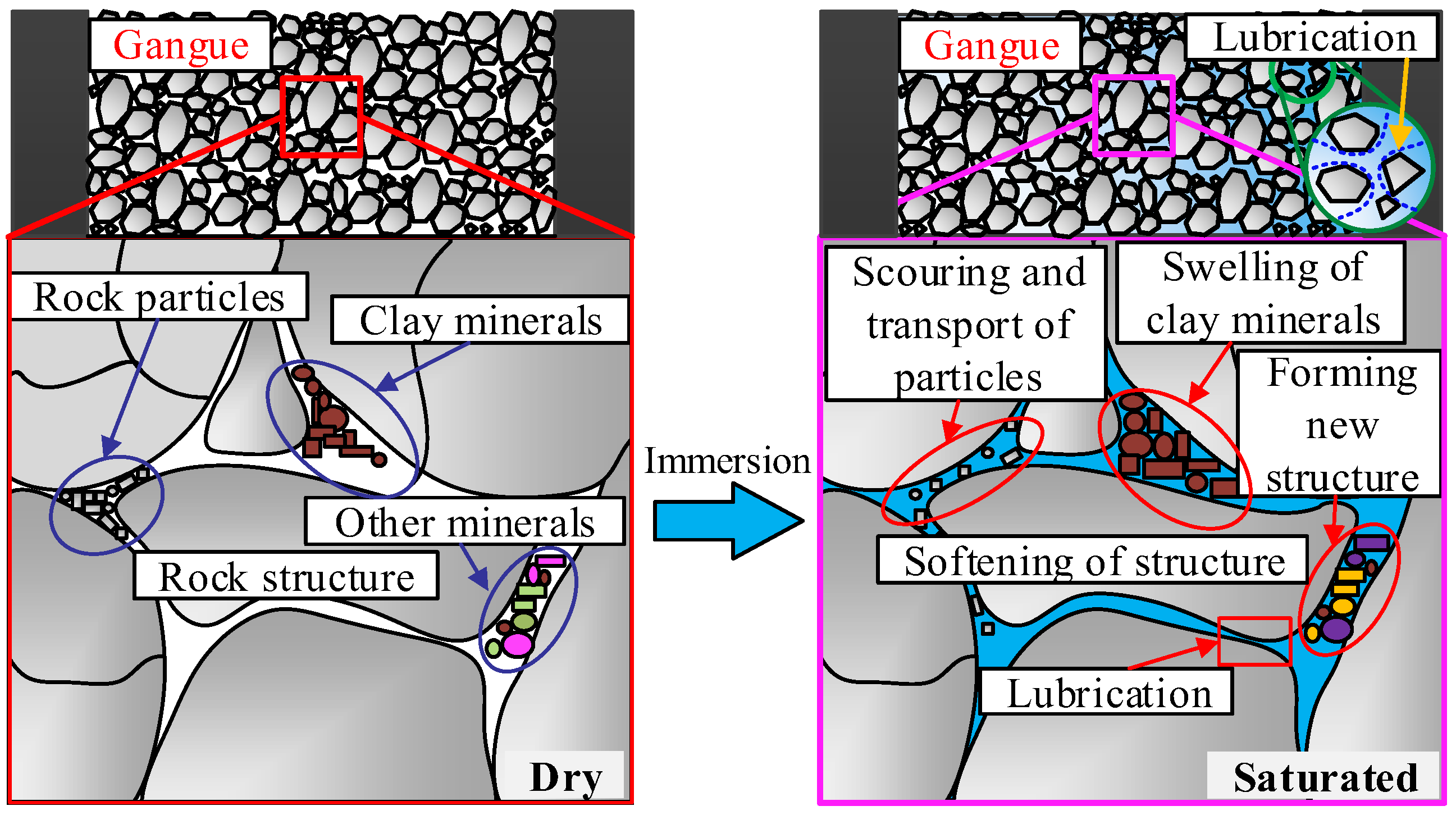
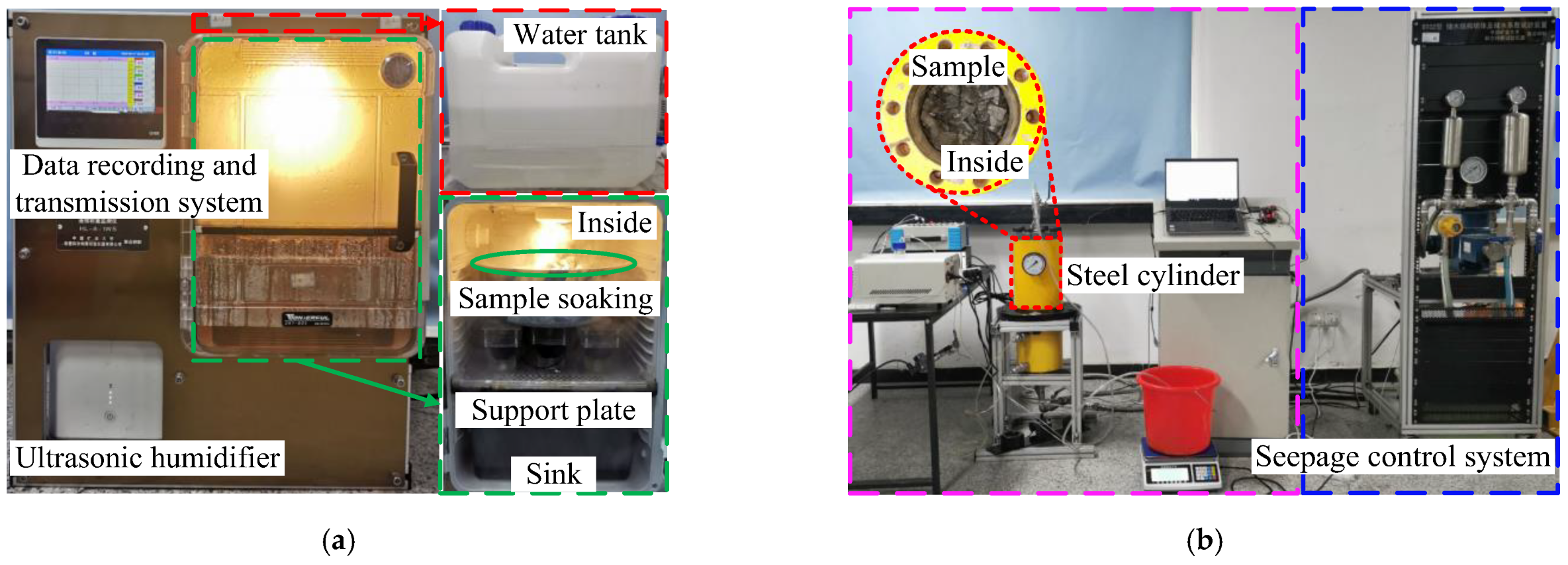
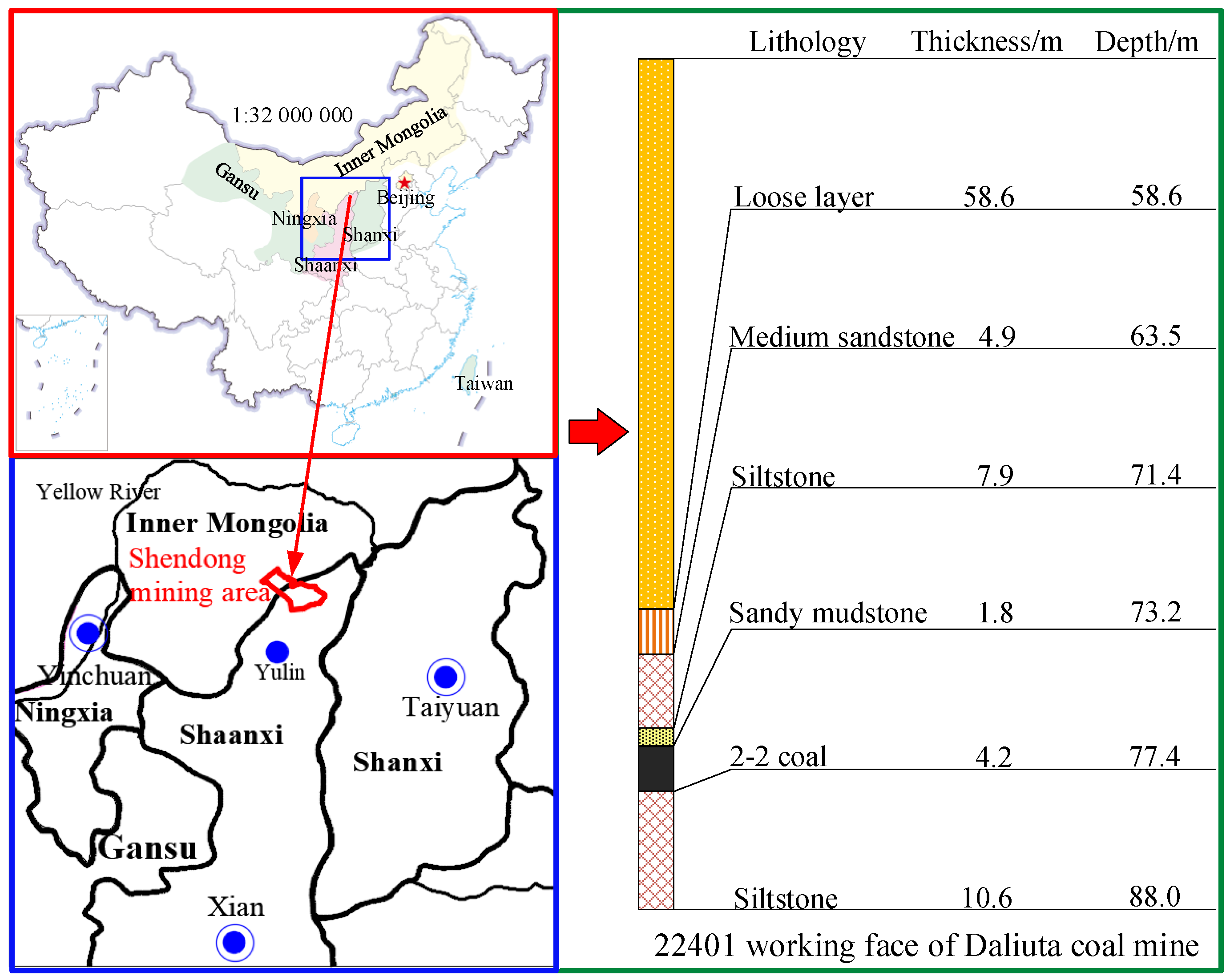

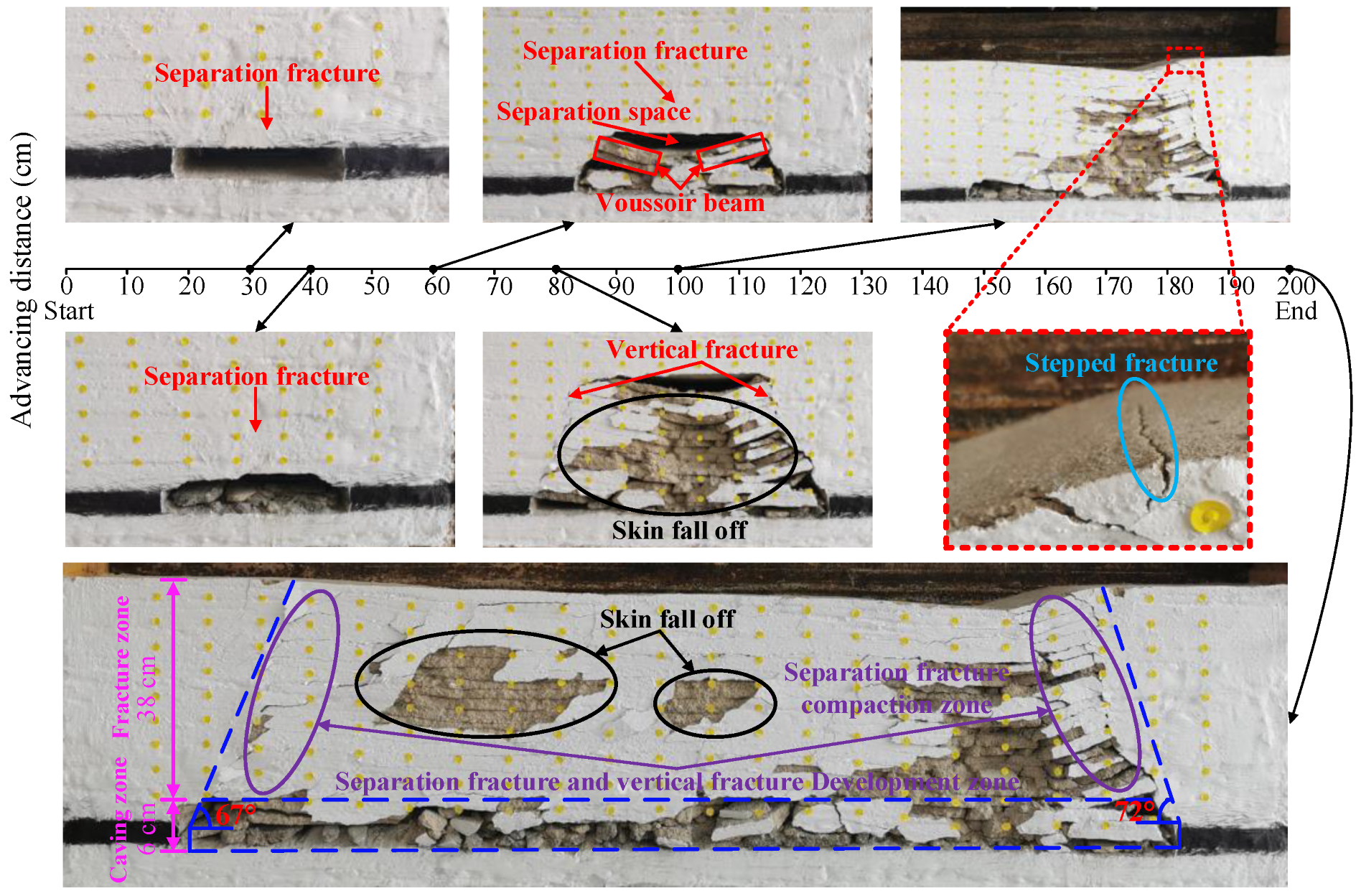
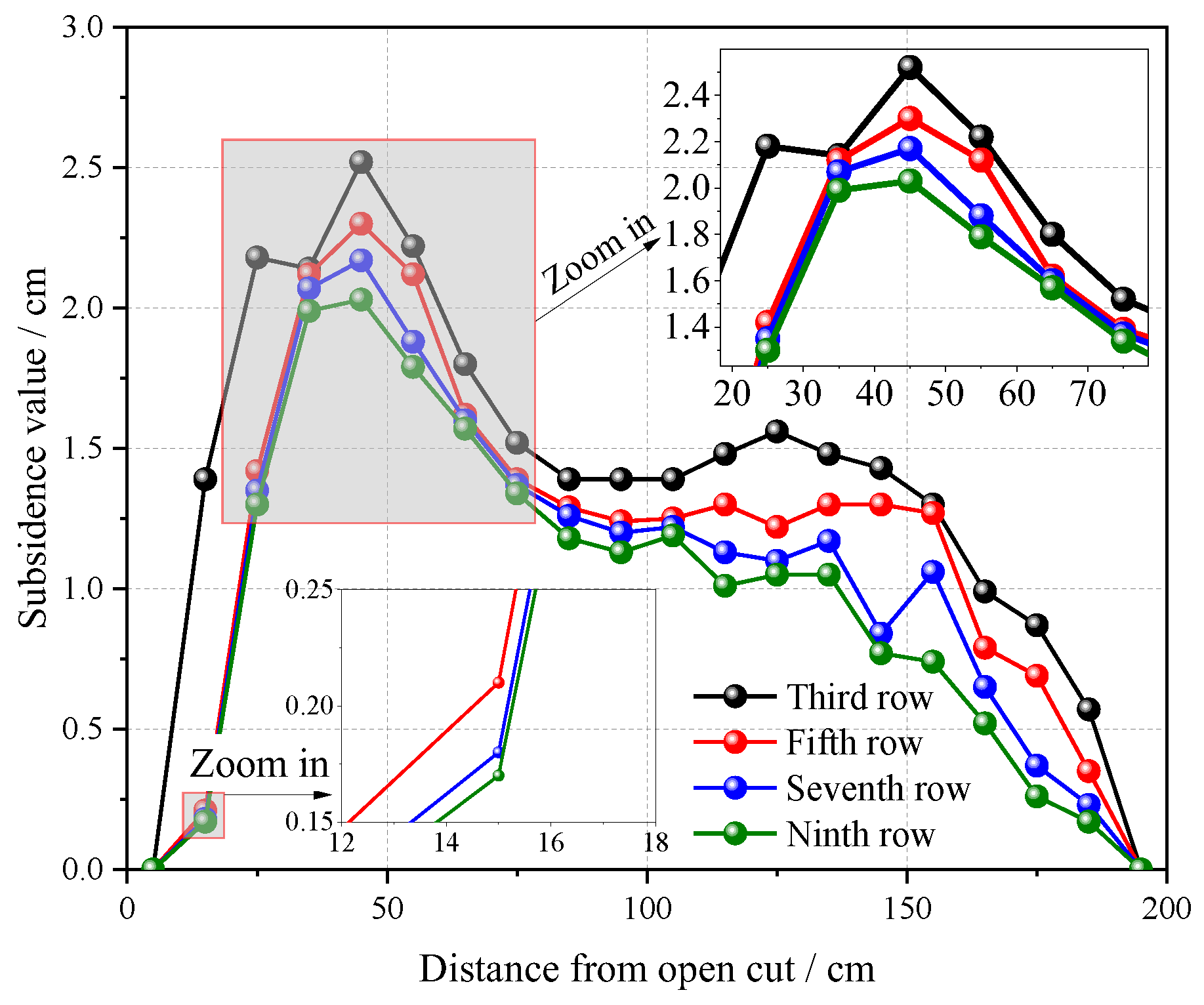
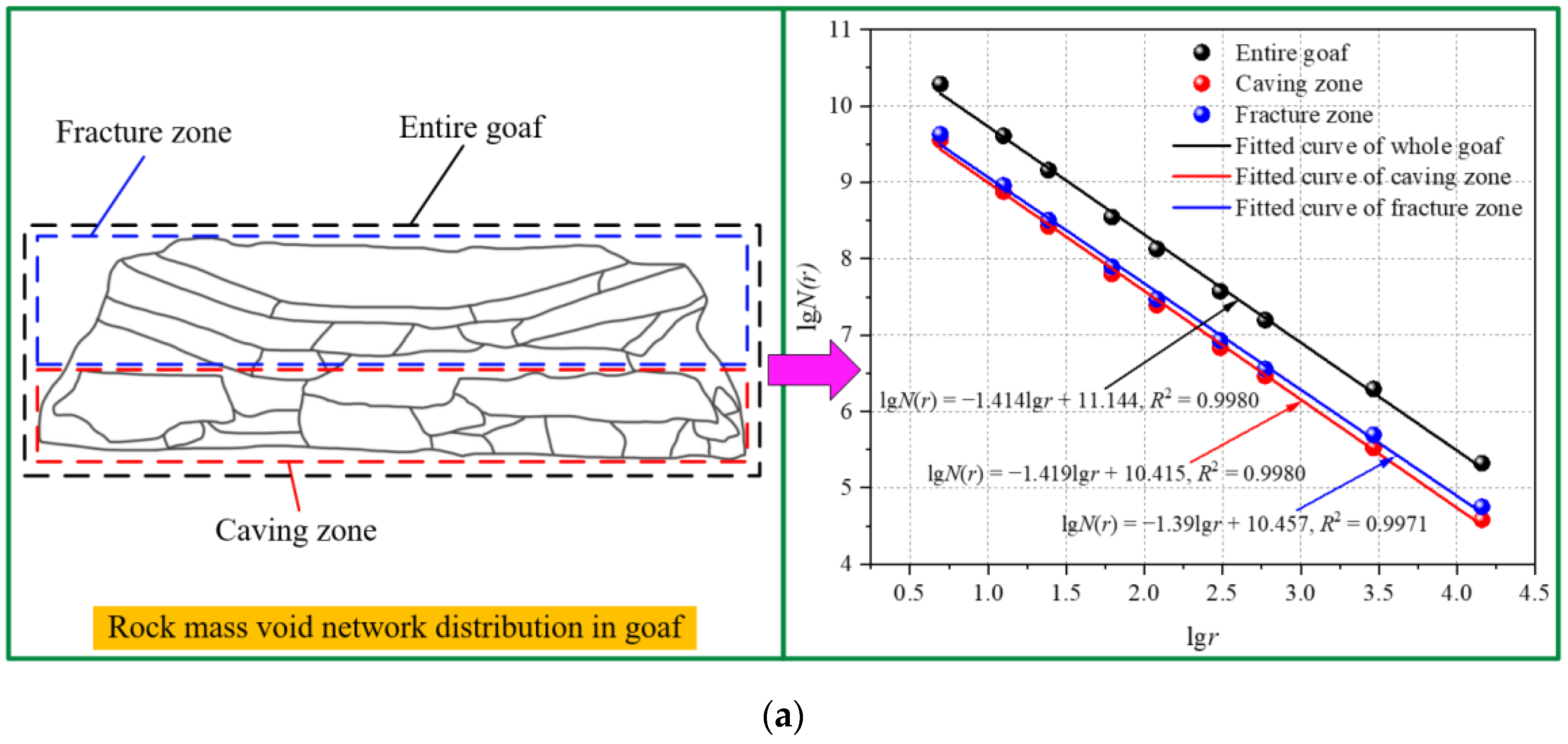
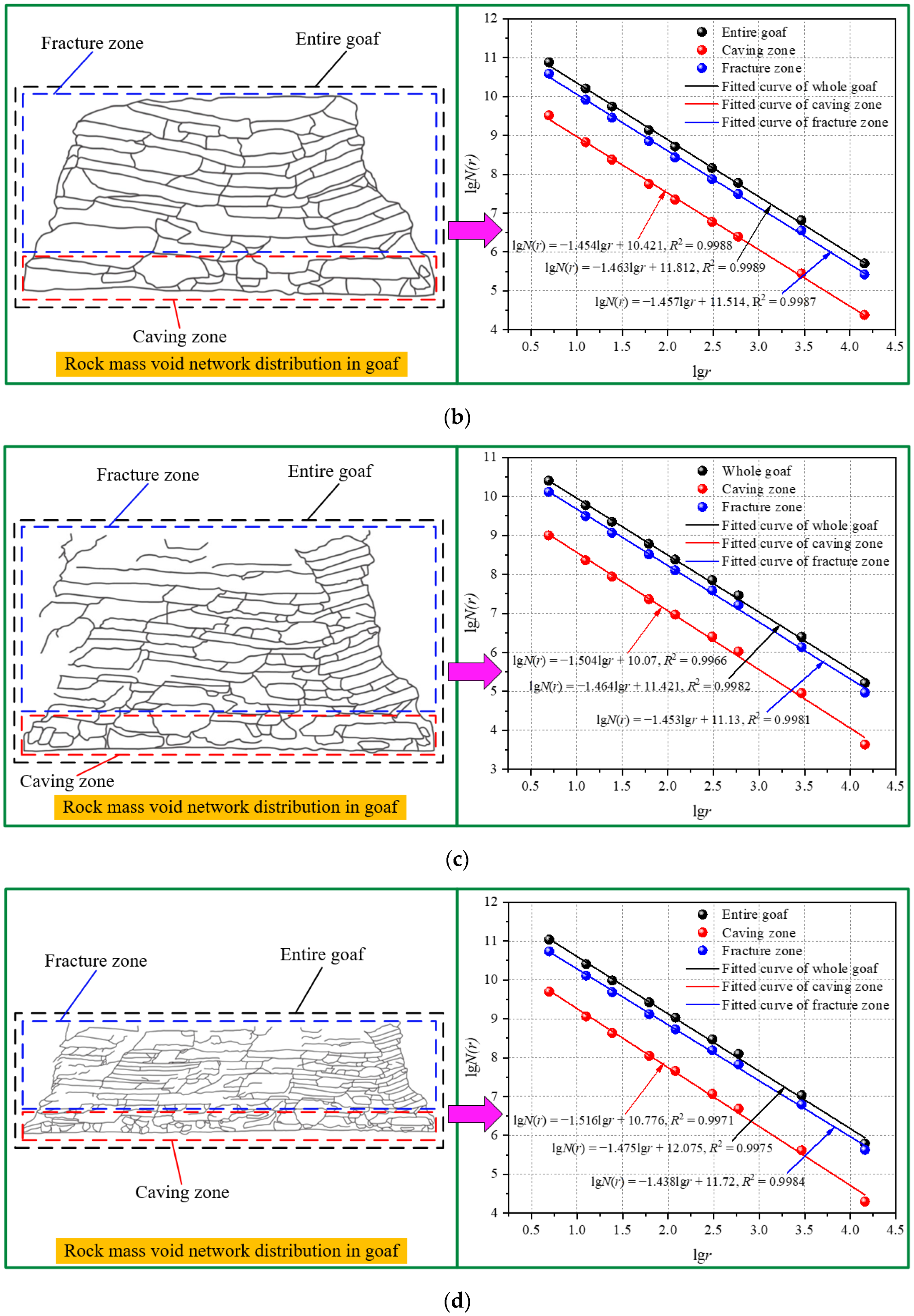
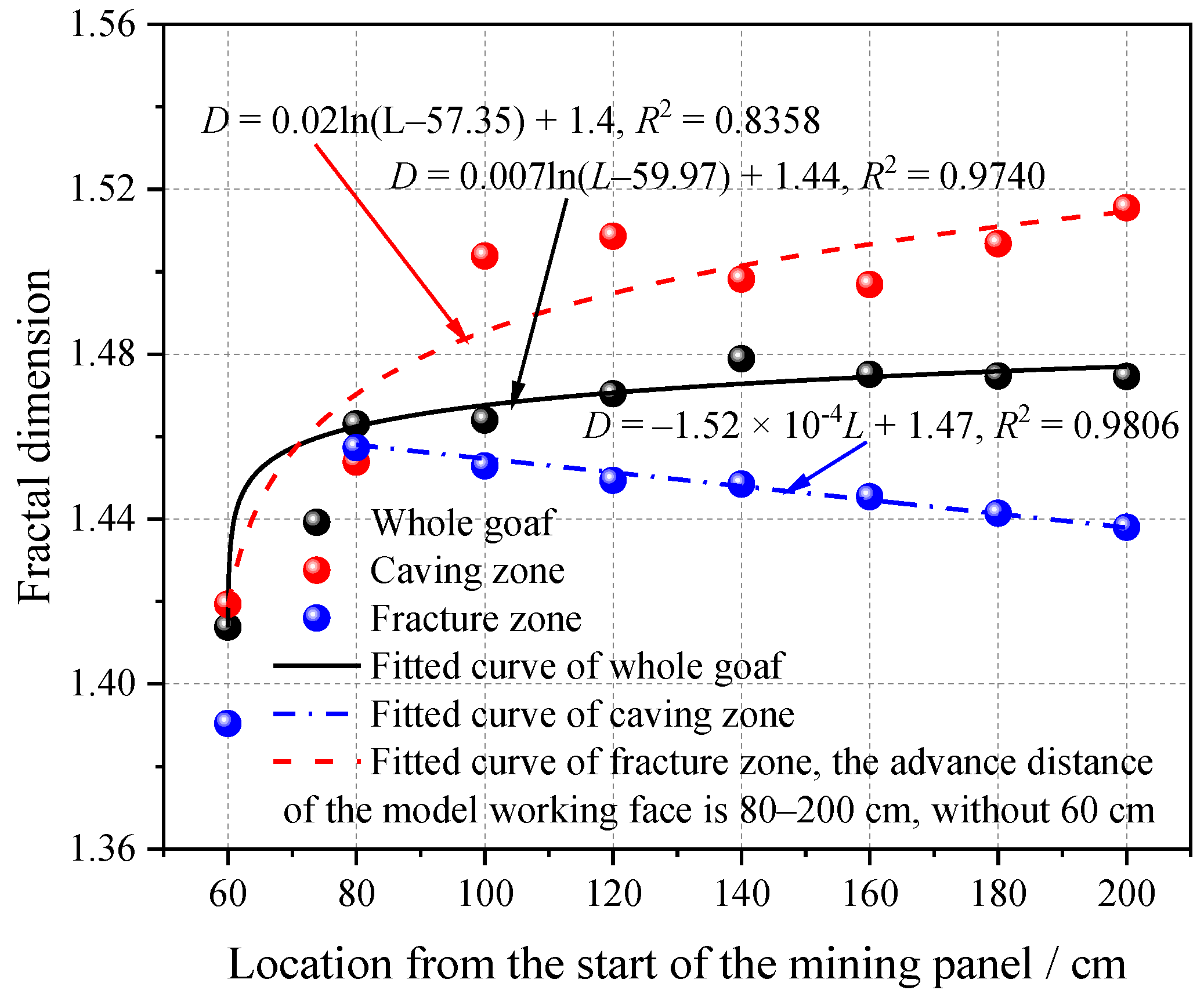
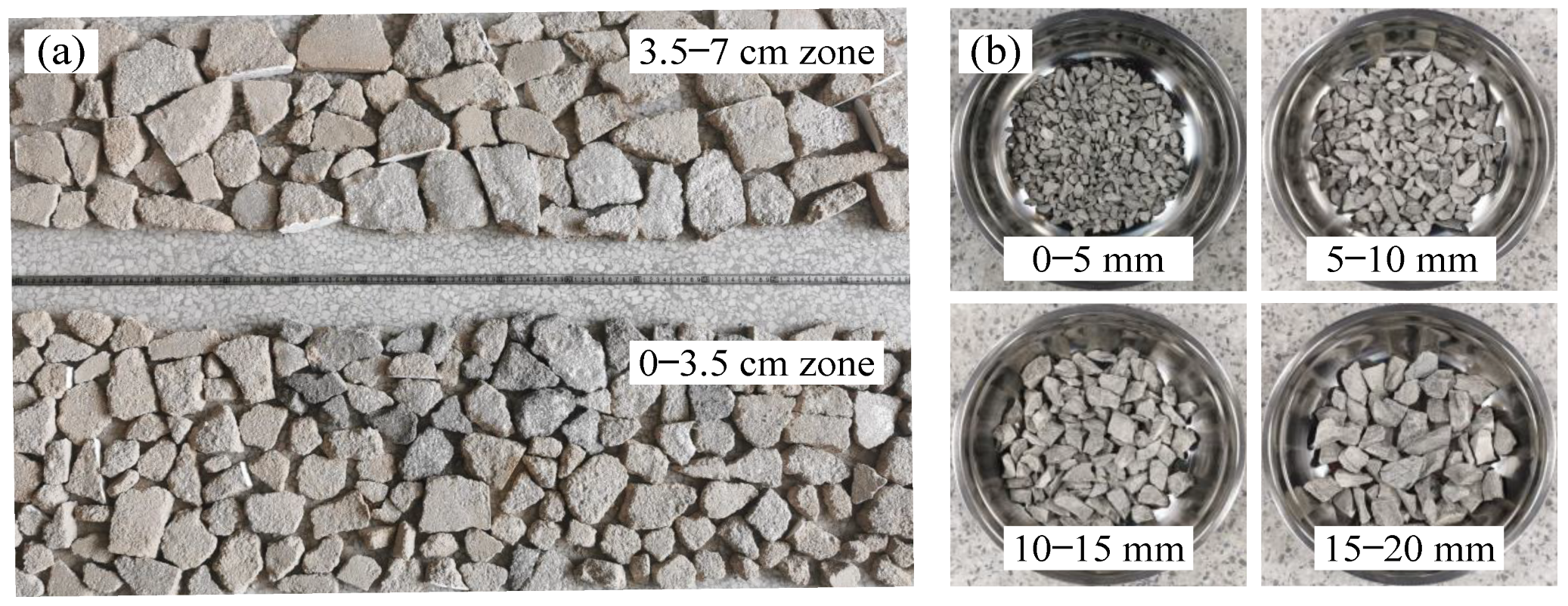
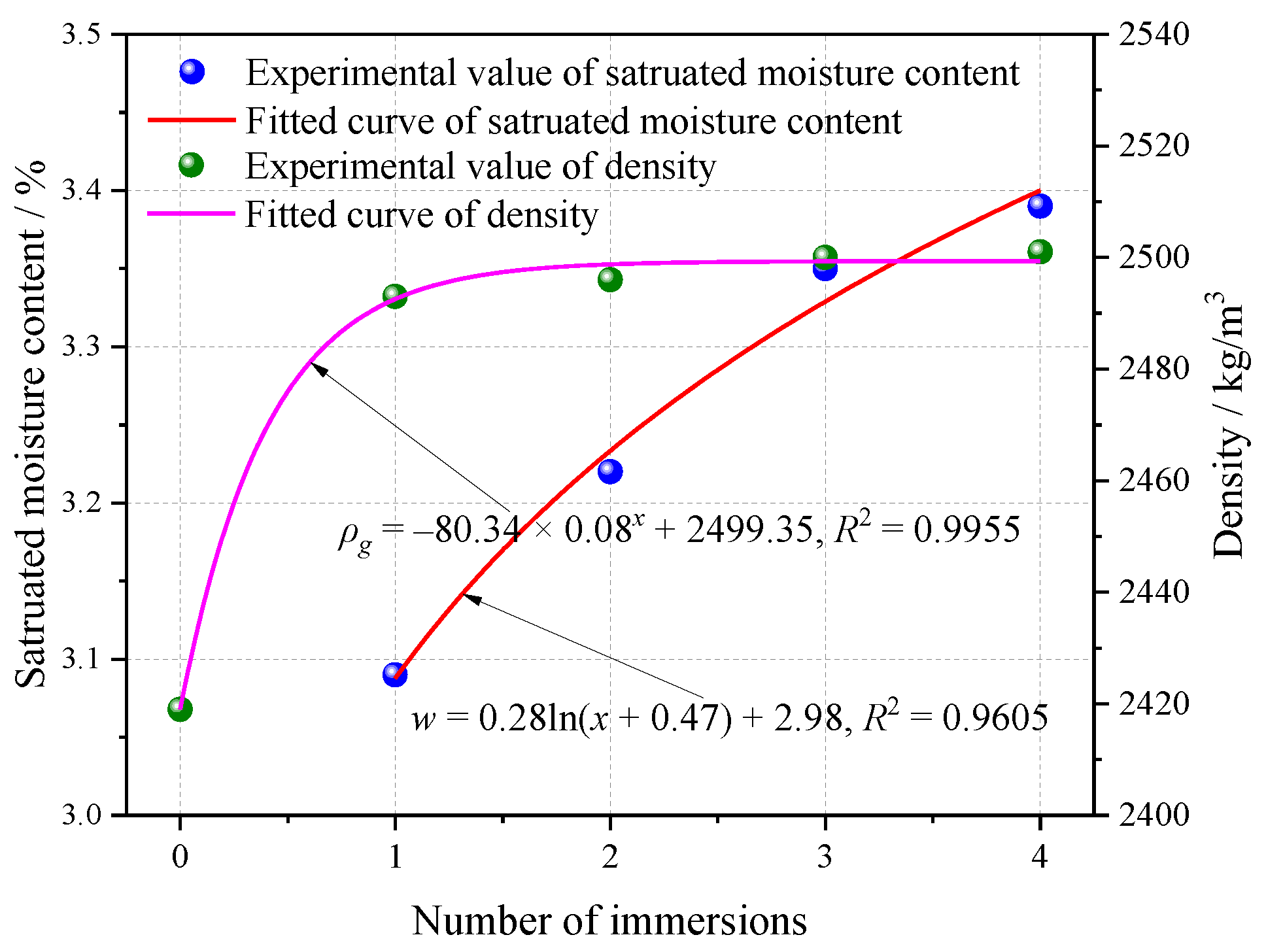
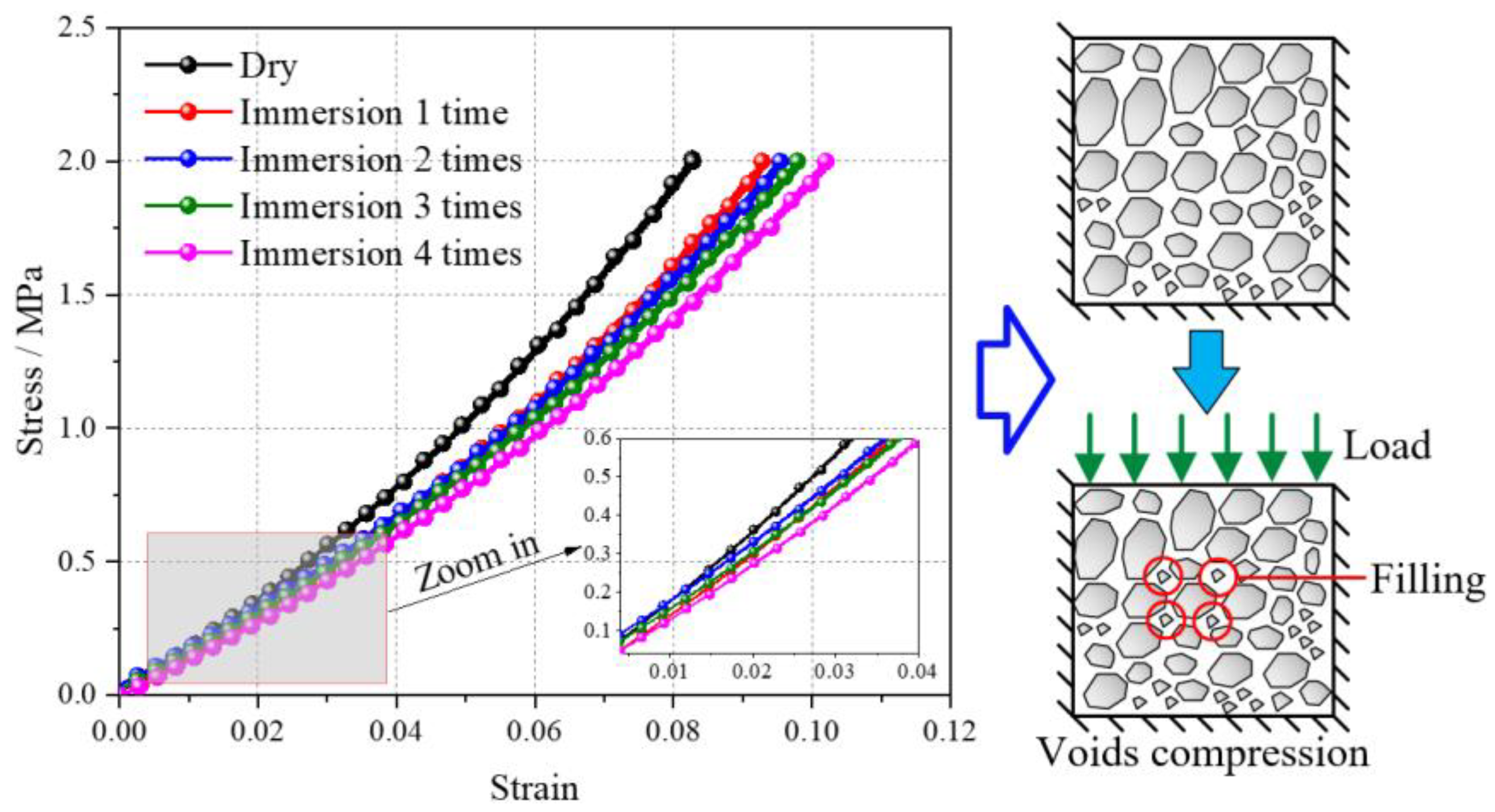


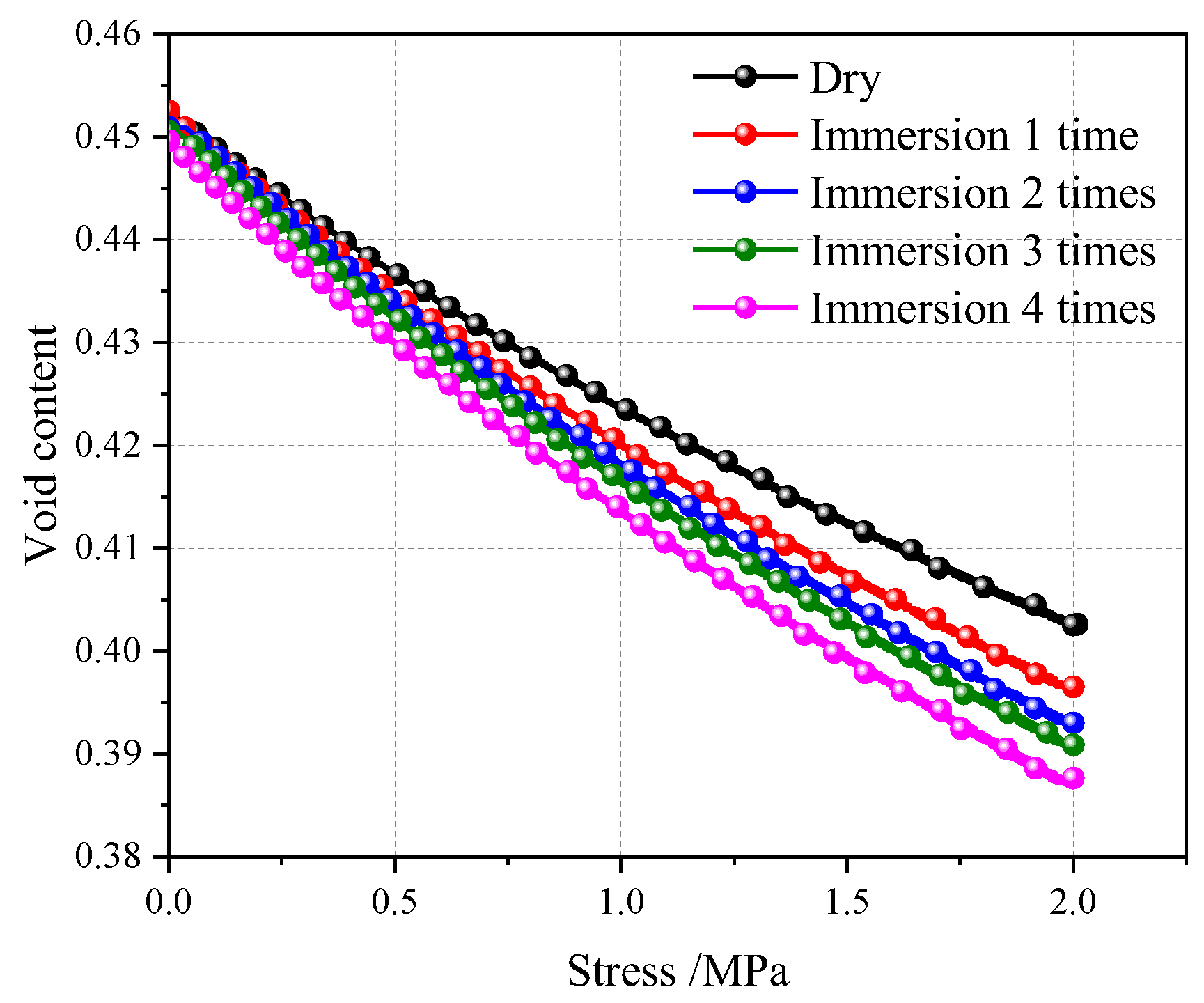
| Lithology | Prototype Compressive Strength/MPa | Model Compressive Strength/MPa | Prototype Density g/cm3 | Model Density/g/cm3 | Material Ratio (Sand: Calcium Carbonate: Gypsum) | |
|---|---|---|---|---|---|---|
 | Loose layer | 0.7 | 0.003 | 1.73 | 1.15 | 11:1:0 |
 | Medium sandstone | 37.0 | 0.164 | 2.57 | 1.71 | 7:5:5 |
 | Siltstone | 26.5 | 0.118 | 2.46 | 1.64 | 7:6:4 |
 | Sandy mudstone | 17.2 | 0.076 | 2.46 | 1.64 | 8:6:4 |
 | 2-2 coal | 15.0 | 0.067 | 1.33 | 0.89 | 8:7:3 |
| Height (cm) | Grain Size Grading (cm) | Ratio (%) |
|---|---|---|
| 3.5–7 | 1–20 | 21.11 |
| 10–15 | 52.55 | |
| 5–10 | 26.34 | |
| 0–3.5 | 10–15 | 24.51 |
| 5–10 | 65.96 | |
| 0–5 | 9.53 |
| Number of Immersions | a | b | c | Fitted Equation | R2 |
|---|---|---|---|---|---|
| 0 | 0.104 | 0.612 | −0.993 | σ = (eε/0.104−0.993)/0.612 | 0.9999 |
| 1 | 0.116 | 0.616 | −1.004 | σ = (eε/0.116−1.004)/0.616 | 0.9895 |
| 2 | 0.121 | 0.617 | −0.976 | σ = (eε/0.121−0.976)/0.617 | 0.9897 |
| 3 | 0.123 | 0.619 | −0.988 | σ = (eε/0.123−0.988)/0.619 | 0.9894 |
| 4 | 0.127 | 0.620 | −1.002 | σ = (eε/0.127−1.002)/0.620 | 0.9893 |
Publisher’s Note: MDPI stays neutral with regard to jurisdictional claims in published maps and institutional affiliations. |
© 2022 by the authors. Licensee MDPI, Basel, Switzerland. This article is an open access article distributed under the terms and conditions of the Creative Commons Attribution (CC BY) license (https://creativecommons.org/licenses/by/4.0/).
Share and Cite
Wang, W.; Yao, Q.; Xu, Q.; Chen, X.; Liu, H.; Li, X. Experimental Study on the Evolution Law of Coal Mine Underground Reservoir Water Storage Space under the Disturbance and Water—Rock Interaction Effect. Minerals 2022, 12, 1491. https://doi.org/10.3390/min12121491
Wang W, Yao Q, Xu Q, Chen X, Liu H, Li X. Experimental Study on the Evolution Law of Coal Mine Underground Reservoir Water Storage Space under the Disturbance and Water—Rock Interaction Effect. Minerals. 2022; 12(12):1491. https://doi.org/10.3390/min12121491
Chicago/Turabian StyleWang, Weinan, Qiangling Yao, Qiang Xu, Xiaoyu Chen, Hengyi Liu, and Xuehua Li. 2022. "Experimental Study on the Evolution Law of Coal Mine Underground Reservoir Water Storage Space under the Disturbance and Water—Rock Interaction Effect" Minerals 12, no. 12: 1491. https://doi.org/10.3390/min12121491
APA StyleWang, W., Yao, Q., Xu, Q., Chen, X., Liu, H., & Li, X. (2022). Experimental Study on the Evolution Law of Coal Mine Underground Reservoir Water Storage Space under the Disturbance and Water—Rock Interaction Effect. Minerals, 12(12), 1491. https://doi.org/10.3390/min12121491





